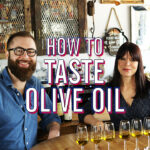Rosengarten Classic. Originally Published: Dean and Deluca Blog, August 2010.
(2013 NOTE: This piece, from 2010, refers to specific olive oils that were young in 2010. In 2013, you should seek out the youngest oils available, as always.)
There is a dichotomy in the world of olive oil that’s every bit as important as the wine world’s red-white dichotomy: some people prefer olive oils made from under-ripe olives, some people prefer olive oils made from fully ripe olives. The styles are as different as night and day. Each style has its advantages…but each style also has its disadvantages.
Let’s start with the olives themselves—about which there’s a widespread misunderstanding. Many olive neophytes think that green olives, and black olives, are two different kinds of olives. T’ain’t so. All olives are green when under-ripe, turn to brown or purple as they’re ripening, then become black at full ripeness .
If you own olive trees, and wish to press the olives for oil, you have a choice to make: should your oil be from under-ripe olives? Medium-ripe-olives? Ripe olives? A mixture?
Some rough generalizations:
Olive oil made from ripe, or black, olives, has a buttery-smooth richness to it. It is warm, mellow, comforting, subtle, with a nutty kind of appeal. Detractors feel it’s too subtle, without the drama of un-ripe-olive olive oil. Ripe-olive oil is the dominant style in Liguria and Provence.
Olive oil made from under-ripe, or green, olives—as in Tuscany—reflects the sharp green-ness of the under-ripe olives. For starters, it has much more of an early-season, “fruity” flavor than ripe-olive oils do; that flavor is often tinged with the greenness of wheatgrass, or raw artichokes. Texturally, it can be less rich than ripe olive oil, not as mouth-coating.
But then we come to the biggest stumbling block of all, for some tasters: green olive oil carries the asperity of under-ripe fruit in two ways. The oil can be bitter on your palate, or peppery-sharp as it goes down your throat.
To lovers of ripe olive oil, these are fatal flaws. But to lovers of unripe oil’s increased intensity, bitterness and piquancy come with the territory. The aficionados argue that olive oil’s not for drinking, it’s for drizzling on food—and a little sharpness is just what you want to wake up your grilled bread, or warm beans, or grizzled steak.
Can you guess? I’m on their side.
I’ve just tasted three great oils that will give you a good idea of the parameters of under-ripe flavor in olive oil. If you’re not used to thinking about olive oil in this way…why not give ’em a try, and see what the shoutin’s all about?
Oleum Viride. This lovely organic Spanish oil, from Sierra de Grazalema in the Cadiz province of Andalucia, is extremely rich, almost soupy—which makes me suspect that there’s a considerable ratio of ripe olives in here. But there’s green as well—as you can discern from the striking bitterness that sets in about mid-palate. I adored it on rich grilled swordfish, the butteriness supporting the fat, the bitterness cutting through it.
Les Terroirs de Marrakech. Made in the foothills of the High Atlas Mountains, this cloudy-yellow oil, with hints of green, features extraordinary and unusual flavors: pumpkin, spice, confectionery. But deep in the back of the throat it wails the unmistakable under-ripe olive song: a peppery burn that lasts for minutes. Another masterful blend of ripe and under-ripe qualities.
Montebernardi, Raccolta 2009, Panzano in Chianti. And, finally, the full-out green-olive-oil deal, a textbook example of young Tuscan under-ripe oil—made less than a year ago, which is the ideal time frame for consumption. The elegant body—rich but not cloying—carries excellent wheatgrass flavor, a scratch of bitterness, and lots of peppery finish. Do as the Tuscans do: grill up a porterhouse, then gild the lily by anointing it with this arrestingly spicy stuff!



